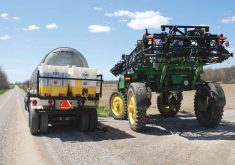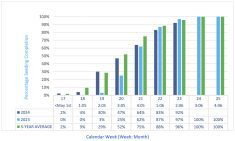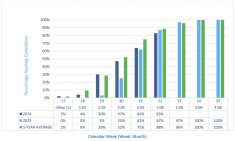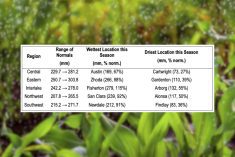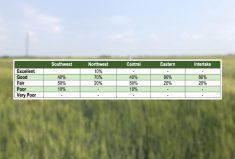Overview
Harvest progress sits at 37 per cent complete across the province, which is ahead of the 5-year average (31 per cent). Winter wheat and fall rye harvest is complete (100 per cent). Yield reports are averaging about 60 bu/acre for winter wheat and 70 bu/acre for fall rye. Harvest continues in spring cereal crops, with barley at 65 per cent complete, oats at 71 per cent complete and spring wheat at 70 per cent complete. Overall, cereal crops remain in fair to mostly good condition.
Corn is mainly in the R5 (dent) growth stages. Canola crops ranged from the swathing/pre-harvest application stage to harvest ready. A limited number of very late seeded canola acres were in late pod fill with straw and pod colour change ongoing. Canola harvest has started with approximately 14 per cent of the acres being harvested across the province, with 30 per cent complete in the Central Region. Field pea harvest is near completion with approximately 94 per cent of acres harvested. Soybean fields are mostly in the R7 to R8 growth stages with harvest beginning on some early maturing fields in the Central region.
Read Also

Manitoba boosts stake in cereals centre to $23.5 million
Premier Wab Kinew said the additional project funds will help ‘Trump-proof’ the provincial economy.
Producers are encouraged to scout their fields for weeds that have escaped control. This is an important part of integrated pest management. Waterhemp has been found in the Central and Eastern regions and producers should seek identification of any unusual pigweeds in their fields.
Cereals
Harvest of winter wheat and fall rye is complete (100 per cent). Yield reports for winter wheat range from 50 to 65 bu/acre and fall rye in the 60 to 90 bu/acre range.
Spring wheat yields range from 35 to 65 bu/acre, with highs of 80 bushels and a low of 16 bu/acre in the driest regions. Oats have been yielding 80 to 130 bu/acre, with some in the driest areas as low as 60 bu/acre being reported. Barley yields are between 70 and 100 bu/acre.
The spring wheat quality is rated mostly fair to good.
Corn fields are in the R5 (dent) stage.
Oilseeds
Canola harvest has started with approximately 14 per cent of the acres being harvested provincially and 30 per cent complete in the Central region. Overall crop condition ranged from fair to mostly good.
Sunflower fields are transitioning from the R8 (back of the head yellow but bracts remain green) growth stage to the R9 (bracts becoming yellow and brown) growth stage. The crop remained in good to excellent condition.
Flax crop growth stage ranged from late stage 10 (green capsule) to mid stage 11 (brown capsule) with lots of variability being noted in fields. The crop was in fair to mostly good condition.
Pulses and soybeans
Field pea harvest is near completion, with approximately 94 per cent of harvest completed. The Northwest region is reporting 85 per cent complete. Early yield reports in the Southwest and Central regions are in the 40 to 55 bu/acre range, whereas the Northwest region is in the 60 to 70 bu/ac range. The majority of the crop is in good condition.
Soybean fields are mostly in the R7 to R8 growth stages with some harvest beginning on the earliest fields in the Central region. Overall crop condition remains good.
Dry bean harvest is approximately 40 per cent complete. Yield ranges from 1000 lbs/acre to just over 2000 lbs/acre are being reported. Yields and quality are variable and dependent on summer rainfall. Areas that received timely rainfall throughout the summer are reporting yields close to 2000 lbs/acre. Seed moisture has been quite low over the past week down to 11 per cent being reported on pinto and black beans. Recent rainfall will rehydrate the seed and allow for more favorable harvest moistures.
Forages & livestock
Forages
Dairy producers have finished third cut, with yields reported as significantly better than second cut.
Beef producers continue to work on second cut.
Baling of straw has begun and will continue on fields as they are harvested.
More producers have begun supplemental feeding out on pasture or hauling cattle back to yards.
Some harvest of annual crops for green feed/silage and a few early fields of corn silage have begun.
Special Note:
- Alfalfa is in the critical harvest fall period for alfalfa and cannot be cut until after a killing frost without increased risk of winterkill.
- Grazing of sorghum and sorghum sudan regrowth should not occur before the new regrowth is at least 24 to 30 inches tall to reduce the risk of prussic acid poisoning.
Livestock
Grass conditions on pasture are variable and highly dependent on moisture levels, grazing management strategy, and soil type.
Some producers are supplementing hay on pasture to ensure nutrient requirements of cattle are being met and to take pressure off the grass.
A handful of producers are beginning to move cattle onto fenced hayfields to graze available regrowth. Water levels in dugouts are low. This is of particular concern on pastures located in areas that have consistently missed out on rain.
Grasshoppers in pastures and hay fields and fly pressure continues to be an issue.
Pastures are holding on in most areas but producers will be looking to move cattle to fall grazing areas.
Slough hay is still being done as dry condition make it easier to cut more sloughs out.
Regional comments
Southwest
A good week of harvest was seen in the Southwest as grains started to dry down by mid-week and general harvest was happening throughout the region. Producers continued with pre-harvest on later seeded cereals and canola. Swathing of canola still happening as producers try to work with uneven crop maturity. Cereal crops are seeing a quality difference as mature crops showed some weathering in the sample from recent rains. In general, crops look average with average yields and good quality. Areas west of 83 highway from Miniota to Reston and through to Pierson are reporting below average yields because of the dry conditions.
Fall rye and winter wheat harvest is complete in the Southwest and yields look to be average with good quality. Producers are starting to plan on winter cereals for 2024.
Wheat harvesting continued this week with several producers getting to 50 per cent complete. In most cases at the beginning of the week producers were harvesting tough grain and are drying or putting in aeration bins. Later in the week most producers were harvesting dry grain. Yields look to be average to slightly above average with good test weight and protein on the early harvested fields. The southern portion of the region has areas with average to below average yields. Barley harvest continued this week and quality and yields are average with some yellowing of the kernels.
Oat harvest continued this week and producers are able to get at standing crop faster than swathed crops but by mid-week all fields were dry. Yields look to average and sample is showing effects of the recent moisture.
Most of the canola crop is in the seed colour change to harvest ready stage. Some producers are swathing and, in several fields, a pre-harvest application was done. Some early seeded canola and canola in dry areas has been harvested and yields look to be average to below average.
The pea harvest is complete. Quality is good. Yield looks to be average with good quality around 45 to 50 bu/acre.
Soybeans are at late R6 to R7 stage. Recent rain has help pod fill and later seeded beans. Most corn is in the late R4 to R5 stage. Crop has managed the dry conditions well, with good height reported in many fields.
Northwest
Generally a good week of harvest progression across the region, with the exception of a day of rain which paused harvest for about a day in some areas. Warm, windy conditions helped to advance crops into maturity. High temperatures over the weekend with highs in the mid 30’s, and overnight lows below 10 C. Precipitation amounts vary across the region. Post-harvest field work has been following harvest completion in most areas, but the push has been to get the crops off while the weather has been good. Smoky conditions developed over the weekend and have been quite strong.
Fall rye and winter wheat harvest is 100 per cent complete. Yields vary widely and are dependent on early season rains.
Spring wheat harvest had a strong push this week with good harvest conditions. Harvest progress varies in spring wheat with approximately 65-70 per cent being harvested, with the exception of The Pas where harvest just started over the weekend. Initial reports are averaging 65-70 bu/acre, with some fields averaging higher (80-90 bu/ace) and some fields well below (30-40 bu/acre). Quality has been good, with mostly grading #1 and # 2 Canada. Some baling has been able to happen after the combine for those that put up straw.
Canola advanced in maturity with recent high temperatures, with the exception of later-seeded fields that are podded but still green. Desiccation/swathing has continued as appropriate stages are reached. There has been a start to canola harvest in some areas, including the Swan Valley and Roblin areas.
Field pea harvest was able to continue towards completion and is approximately 85-90 per cent complete. Yield range is mostly dependent on precipitation through the season. Fields with little precipitation ranged from 40 to 45 bu/acre while better fields are at 60 to 70 bu/acre. Baling of pea straw occurring. Some post-harvest field work has been done as crops removed.
Soybeans were able to advance rapidly with the recent high temperatures over the last few days and are in the R7 with earliest fields approaching R8 stage. A few fields that have been stressed through the season and on lighter land are in the more advanced stage.
Central
The hot and windy weather allowed for rapid dry down of crops. Swift progress was made on spring cereals, canola, and edible beans, as well as the first harvest of soybean fields. High winds, however, resulted in challenges for producers swathing canola, with swaths perpendicular to winds being the most affected.
Winter wheat and fall rye harvest is complete. Fall rye yields have varied greatly depending on how much rainfall the crop received this year, with most yields in the region of 60 to 90 bu/acre. However, some fall rye yields are as low as 30 bu/acre. Winter wheat yields are around 60 bu/acre.
Harvest of spring cereals is mostly complete, with spring wheat, oat and barley harvest sitting at around 95 per cent. Cereals are mostly at full maturity, with a few still at the hard dough stage. Spring wheat yields are highly variable, depending mostly on how much rainfall the crop received during the growing season. Most spring wheat yields have been in the region of 35 to 65 bu/acre, but yields have ranged from as low as 16 bu/acre to as high as 80 plus bu/acre only a few miles away. Oats have been yielding 80 to 130 bu/acre, with some in the driest areas as low as 60 bu/acre. Barley between 70 and 100 bu/acre.
Corn is at the R5 (dent) stages. Most of the crop looks promising; however, fields that have received the least amount of rainfall have observable wilting symptoms and cob tip dieback. The earliest silage cornfields have been harvested, with yields ranging between 13 to 15 tonne/acre.
Field pea harvest is complete, with the last fields harvested at the beginning of the past week. Most yields have been around 45 to 60 bu/acre; however, on some of the driest fields yields are as low as 30 bu/acre. The most favorable fields have been as high as 75 bu/acre.
Canola harvest continues, with harvest progress sitting at approximately 30 per cent. Those still planning on herbicide application or swathing will start in the coming days. Yields vary greatly, between 20 to 55 bu/acre, with averages closer to the 30 to 40bu/acre. Flax is approaching harvest, with most fields at stage 11 (brown capsule). Sunflower fields were mostly in the R8 (back of the head yellow but bracts remain green) stage or R9 (bracts becoming yellow and brown) stage.
Soybean harvest has begun on the earliest maturing fields where lack of moisture was evident throughout the season. Most soybean fields remain around R7 (one or more brown pod on the main stem), with the early maturing varieties at, or approaching, R8 (95 per cent brown pod). Cutting and harvest has begun on the most mature dry beans, with harvest at approximately 40 per cent. Edible bean yields range from 1000 to over 2000 lbs/ac. White mould has been noticeable in some soybean and dry bean fields.
Eastern
Over the last week a few districts across the region received rainfall accumulations that ranged from a trace to 5 mm, while most areas saw no appreciable rainfall. Daytime and nighttime temperatures started the reporting period at seasonal levels but warmed to well above seasonal levels by the end of the week and over the weekend. These hot conditions were accompanied by strong winds that worked to accelerate crop dry down. With this weather, producers were able to make rapid progress on spring cereal harvest and accompanying fieldwork. Producers look toward making good progress on wrapping up cereal harvest and moving fully into canola harvest in the coming week if the weather allows.
Spring cereal crops were mostly harvest ready with some late seeded material at the pre-harvest application/swathing stage. Spring wheat harvest was about 80 per cent complete with about 60 per cent of oats and barley completed. Average yield on spring wheat has been better than expected at around 65 bu/acre with 13.5 per cent or higher protein levels and grading #1 or #2 Canada. Oat yields reported thus far have ranged from 50 to 120 bu/acre. Application of pre-harvest herbicides and swathing was pretty much complete except for some very late seeded fields.
Corn fields were in the R5 (dent) growth stage. The majority of the crop remained in good to excellent condition. A limited number of fields on lighter soil profiles located in low rainfall areas were showing signs of moisture stress and starting to dry down prematurely.
Sunflower fields were transitioning from the R8 (back of the head yellow but bracts remain green) growth stage to the R9 (bracts becoming yellow and brown) growth stage. The crop remained in good to excellent condition.
Most canola crops in the region ranged from the swathing/pre-harvest application stage to harvest ready. A limited number of very late seeded canola acres were in late pod fill with straw and pod colour change ongoing. While canola harvest has started, less than 10 per cent of acres have been combined thus far. Canola harvesting is expected to become more general this week if weather allows. Swathing and pre-harvest herbicide applications were about 30 per cent complete and expected to proceed rapidly this week with appropriate weather. Agronomists noted that timing pre-harvest herbicide applications has been challenging this year because of the unevenness of crop development found in many canola fields which has led to delays. Overall crop condition ranged from fair to mostly good.
Flax crop growth stages ranged from very late stage 10 (green capsule) to late stage 11 (brown capsule) with lots of variability being noted in fields. The crop was in fair to mostly good condition.
Most soybean fields were in the R7 (one or more brown pods on the main stem) growth stage with ample leaf colour change and leaf drop. Fields of early maturing varieties were approaching the R8 (95 per cent brown pod) growth stage and dry down. Overall crop condition remained good on most fields. The presence of white mould continued to be noted last week, particularly in fields seeded to later maturing varieties that have rank, lush plant growth and high yield potential. Field pea harvest was complete. Overall, yields were higher than expected given the periodic dry conditions experienced earlier on in the growing season and averaged out at around 70 bu/acre with good quality.
Interlake
Precipitation continues to be variable with scattered thundershowers with minimal amount of rainfall in some areas of the Interlake region. Area just north of Arborg received 25mm on Thursday, which will delay harvest and affect grain quality on swathed crops. Farmers are having a difficult time harvesting dry grain due to high humidity and heavy dew in the morning. Temperatures have declined to a certain extent, with average temperatures ranging from 18 to 19 C. Most of the region saw highs of 22.5 to 25.6 C early in the week, but have dropped into the teens. Overnight lows are down to 5 to 7 C. Most crops are past the stage of benefiting from rain, but fill may improve in late-maturing crops.
Harvest continues but with minimal delays following recent showers in the Interlake region. Harvest is well advanced in some areas in the south Interlake region but very slow in the Arborg area and the north Interlake. In general, the harvest process varies across the region depending on moisture, variety, and seeding dates.
Spring wheat harvest continues with about 60 per cent complete with proteins levels ranging from 13.0 to 14.5 per cent with yields reported from 65 to 70 bu/acre range. Some producers have reported spring wheat yields to be below and slightly above average, depending on rainfall. Oat harvest is about 80 per cent done and barley is about 90 per cent done with yield estimates of 120 bu/acre and 80 bu/acre, respectively.
Soybean are turning rapidly in some fields. Most soybeans have advanced to the R7 stage, but vary across the Interlake region.
Canola crops in the region ranged from the swathing/pre-harvest application stage to harvest ready. A limited number of very late seeded canola acres were in late pod fill with straw and pod colour change ongoing. Canola harvest is underway with 5 per cent of the crop being harvested. Verticillium stripe has been reported in some fields.
Silage corn harvest has started in some areas of the North Interlake with yields ranging from 14-15 tonnes per acre. Sunflowers are at R7 to R8 stage; the crop remained in good to excellent condition.




